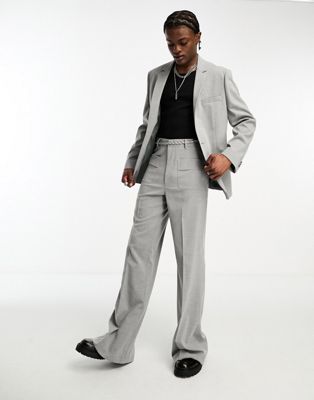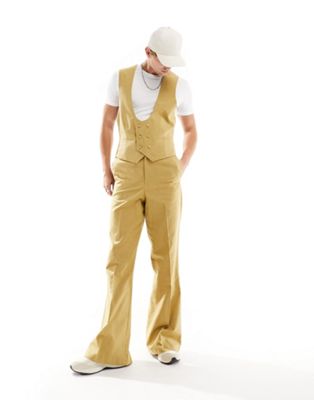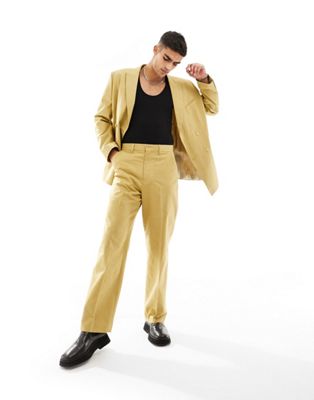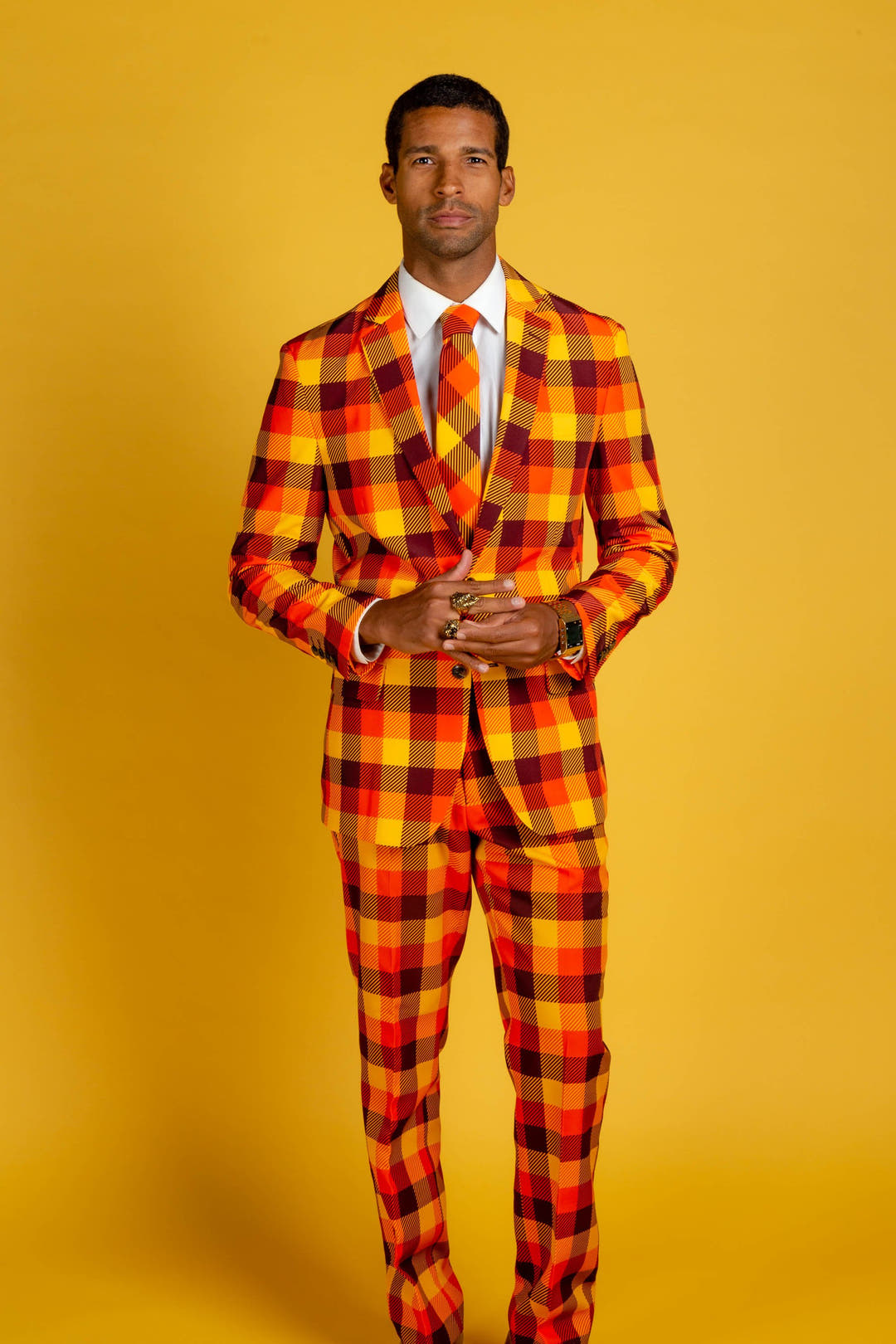While the 60s was the decade of the boyish skinny suit with some unique features in collar and jacket shape, the 1970s was the decade to play with every cut, color, and fabric imaginable. It was known as the “peacock” look because men over-dressed themselves in flashy suits, shirts, and footwear, often outstyling women’s wear at the time. This showy new look began in the early 1960s, but took until the end of the decade to find it’s home in the 1970s.
- 1970 mod tunic suit with oversized collar
- 1970 Mod Meets the 70s Suits
1970s Men’s Suits
“Wide lapels up to 5 inches, notched or peaked, with ‘hard’ construction for the crisp, custom look. The Tube Look which is tall and slim, narrowed chest, higher robed shoulder, lower ‘natural’ waistline, less flare in the coat skirt, straight leg trousers… jackets continue to open up to show more shirts, more tie.” – The Individualist: He’ll Wear the Hard Wide Lapel. Gordon, 1969.

1973 Sears notes “unstructured suits” are in style
The early 70s saw suit designers turn back to the golden age of Hollywood for inspiration. The wide fit on a slender body was the ideal 1930s very masculine man. New Hollywood movie were made depicting life in the 1920s and 1930s, remaking old suits with polyester knits and exaggerated details. Watch Cabaret (1972), The Sting (1973), and The Great Gatsby (1974) to see these 1970s does 20s/30s remakes.

Robert Redford as Jay Gatsby in the Great Gatsby- Suit lapels and tie are very wide
Polyester double knit, despite its heat sealing, unbreathable nature, was the ideal fabric for a new wave of colors, patterns, and textures. Plus, it never wrinkled. Teal blue, hunter green, mulberry red, sienna brown, cornhusk yellow, chalk blue, pink, tan, cream/ivory, and white spattered across the pages of magazines and televisions. Neutral colors such as navy blue, grey, and brown were still the safest choices at the professional office.
Young men who rebelled in the 1960s found their way into board rooms, using their fancy new degrees in the real world. They dressed in stiff double-knit polyester fabrics, with extra wide unmovable notch flat lapels, large pocket flaps in unusual shapes (curves, scallop, button down, pleated), 2 button fronts, and curved front coat edges. This style remained unchanged for most of the 1970s.
- 1973 grey or brown suits (notice the shaped pockets)
- 1973 steel blue and navy suits
Suit slacks or trousers rose up to the middle to high waist after having fallen to hip hugger status in the 60s. The flat front and wide leg trouser hung straight down in a tapered column, often with a deep cuff. Inseam or high welt pockets kept the front smooth.
- Youthful “trim fit” suit trousers fit slightly lower on the waist and tighter in the thigh before flaring out at the cuff, ending an inch shorter than full fit trousers.
- “Full fit” slacks had a mid waist rise, more room in the seat with a full leg throughout, and minimal if any flare.
Both suits slacks had a sharp press down the leg starting at the lower fly. A wide belt held them in place.
- 1971 full leg (L) and trim fit/flare leg (R)
- 1974 slacks both full and trim/flare leg
Most suits came with a matching vests. 1970s suit vests had no lapels, 5 buttons, point tips, and two patch pockets on the sides. Because of the high rise of trousers, vests had short torsos. The vest design changed little throughout the decade.

1977 three piece suit with vest
It was difficult to find matching suit and trouser pictures became most men mixed and matched suit jackets/sport coats/blazers with trousers and vests. This mixing allowed men to show off more color and pattern in their wardrobes. Solid color and patterned vests could be mixed together to create multiple outfits with a few coordinated pieces. It was more common to match the vest with the trousers and have a contrasting suit coat.
- 1977 Suit Separates in Blue, Cream, and Navy
- 1977 suit separates in blue or grey windowpane
Denim Suits
Denim was BIG in the 1970s. Everything, and I mean everything was made with denim. For menswear, the denim suit was the perfect blend between casual and business wear. All colors of denim could be made into a suit, but the deep blue denim dominated the decade. Light blue denim was also on trend and looked more like polyester suiting than denim jeans. Many denim suits took on traditional western details such as contrast stitching.
- 1976 LEE Blue Denim Suit
- 1976 LEE denim suit with contrast stitching
- 1977 light blue denim suit
- 1977 tan denim suit
Armani Suits
Between 1975 and 1977, Giorgio Armani from Milan, Italy developed a softer men’s suit. In 1977 GQ wrote “All construction was removed, leaving a supple and easy-to-wear shell. The shoulders were subtly emphasized, indirectly leading to this season’s squarer, more exaggerated shoulder; and the jacket’s cut was carefully worked to showcase a man’s body. Armani calls it ‘A study in making men look sexier.'” Armani used fine fabrics woven from natural fibers instead of polyester knits.

Sears 1976 European Look suits
Mainstream designers called the new suits “European fit.” Sears describes them as such: “This is the European look that gained handsomely in Sears translation. Jackets are shaped, but not too severely. Shirts are trim without being tight. Trousers are cut slim on top rather than skinny. It’s the European Look with a slight American accent. It’s the best of both worlds.” – 1976 Sears catalog.
The late ’70s, men’s suit came in the same colors as early suits. Pastels and cream tones in summer, brown, blue, and grey in winter would lead the next decade into corporate America ’80s.
- 1978 teal and blue summer suits by JC Penny
- 1978 tan and cream suits by Montgomery Wards
- 1979 pastel summer suits by Montgomery Wards
- 1979 men’s business suits by Sears
1970s Dress Shirts
Men’s dress shirts mirrored the broad padded suits with oversized point collars and cuffs as well as bold colors. Shirt collars were high banded and wide spread to accommodate wide knot ties. Despite these excessive pieces the overall fit was trim to the body with tapered side seams and darted backs. Shirts were tucked in and had to be perfectly smooth under the waistline and belt. Short sleeves were preferred over long sleeves.
Polyester knit shirts were the best at retaining the smooth shape. When made in big patterns and bright colors they were impossible to tell the difference between dress shirt and sport shirt.
- 1973 knit dress shirts
- 1974 men’s plain or stripe dress shirts
- 1977 mens bold dress shirts
- 1978 men’s short sleeve dress shirts and ties
1970s Sport Coats
Sport coats and some casual suits took on big, bold prints such as chalk gangster stripes (revived from the 20s-40s), narrow boater stripes, plaid, windowpane, houndstooth, and checks. While these patterns were worn in the 60s too, the 1970s sport coat with oversized jackets made the pattern appear even bigger. Many patterns were mixed with white, which also created a larger contrast.

1972 fashion spread in Ebony Magazine for men’s plaid sport coats
- 1973 red plaid sport coat
- 1974 red or brown hounds tooth sport coat
- 1974 Blue Check Sport Coat
- 1975 blue or tan windowpane sport coat
More liberties were taken with sport coat pocket shapes, lapels (peak or notch), button materials (brass, plastic, covered leather), and other trimming than with suits.

1971 sportscoat on stripes, plaid or solid tones
The early 70s saw the belted sport coat trend. It was originally inspired by the Norfolk suit, a precursor to the casual sport coat from the pre 1940s. There could be a full belt with buttons or slide in the front or a half belt back, as well as different types of vents and pleats. The sport coat usually had 2-4 large pockets each with unusually shaped flaps or contrasting buttons.
The suit vest also took on a Norfolk belted style with a longer length, two pockets, and slide belt. The trend didn’t last long. By 1972, most Norfolk suits were out of style, although they are very collectable today.
- 1971 belted back, belted all around, inverted pleat back
- 1971 Norfolk style suit
- 1971 belted suits vests
Blazers
Men’s solid color blazers were equally as trendy as patterned sport coats. In the early to middle years, bright primary colors reigned such as red, navy blue, bright blue, white, green, and yellow. In the second half of the 1970s decade colors toned down as neutrals – tan, navy, hunter green, grey, burgundy – fit the new professional businessman’s look better.
- 1973 piping edge mod blazers
- 1975 Summer Blazers and Plaid Trousers
- 1973 fall tone blazers
- 1974 primary color blazers
Corduroy Sportcoats and Suits
While polyester double knit was the fabric of the 70s, there were other popular fabrics for men’s sportscoats and blazers. Corduroy excelled as a durable, fall and winter friendly fabric in neutral colors. Tan or green corduroy were the best colors with optional suede elbow patches and pocket trim. Corduroy was made into suits, sport coats, blazers, and leisure suits.
Suede sport coats also deserve a mention for the early years, but were mostly used for casual jackets the rest of the decade.
- 1971 corduroy blazers in tan, brown and green
- 1976 corduroy suits and leisure suits in yellow-tan
1970s Leisure Suits
Casual suits or leisure suits were a new idea in the 1970s. Other than sport coats, menswear designers had not attempted to make an unstructured suit fit for a more casual lifestyle. What separated leisure suits from business suits was the straight edge jacket that was completely unlined. Two chest pockets also replaced hip pockets. The jacket looked more like a button down shirt than a suit.
There were more experiments with designs on these suits such as yoke shoulders, decorative metal buttons, contrast piping, vertical pleats, pleated pockets, and rolled cuffs. The western influence was strong.
- 1975 light blue denim leisure suit
- 1977 leisure suits with piping lines
The leisure suit jacket took notes from bush shirts and jackets, also popular in the 1930s and again in the 1960s. The “bushcoat” jacket had four pockets: two on the chest and two at the hips, and all four were large with unusual flap shapes. Some even had brocade trim. They were trimmed with high roll collars with deeply wide and pointed tips. The bushcoat was more popular as a casual jacket than as part of a leisure suit.

1975 four pocket safari or bush suits
Leisure suit colors expanded even more into summer pastels – mint green, peach, baby pink, wheat, and yellow. White was an especially popular color at Disco dances, where the rotating lights reflected off the white suit like a crystal chandelier.

1975 white leisure suit
Young men embraced these new styles and paired them with a vest when going for a semi-formal look. The deep V vest was sleeveless and long, like a tunic shirt with an attached skirt. Most casual looks ditched the vest altogether.
- 1977 sky blue and mint green leisure suits
- 1977 leisure suit with vertical pleats
- 1978 leisure suits
- 1979 leisure suits
Tuxedos
Starting in the late 60s, men’s formalwear designers were using synthetic blend fabrics in shiny paisley and brocade patterns on dinner jackets. A few remained into the 1970s but like men’s day suits, the tuxedo favored rich colors, pastels, and cream instead. Many had black outlining or velvet lapels to give them even more funk.

1970s cream cutaway coat tuxedo suit with black lapels
Tuxedo jackets came in every cut that day suits did plus a revival of some very old suits: the morning suit/cutaway and the tailcoat. Added to them were bright colors such as powder blue, yellow, mint green, midnight blue, and electric blue. White, cream and tan were also welcome suit colors for weddings.
- Powder blue cutaway tuxedo coat with ruffled shirt, vest and bow ties
- 1976 midnight blue with black trim tuxedos
- 1977 tan wedding suit
- 1976 double breasted yellow blazer with black piping over black tuxedo pants
Black was the only color not seen very much except in wealthy or famous circles, where traditional black tie was seen as luxurious. Shaping followed that of day suits – wide lapels, contrast edging, and flare leg trousers.
Entertainers had custom suits made in extra flashy materials embellished with sequins.
- Sonny’s black tuxedo
- Cher with Sonny Bono wearing a gold sequin suit
Tuxedo shirts in the 1970s went back to the Edwardian age with an abundance of ruffles on the bosom and cuffs. Butterfly bow ties were oversized and soft to match the shirts’ soft form. Offered colors were a rainbow of eye popping hues.

1976 ruffled tuxedo shirts with butterfly bow ties
Buy Men’s 1970s Style Suits
Debbie Sessions has been teaching fashion history and helping people dress for vintage themed events since 2009. She has turned a hobby into VintageDancer.com with hundreds of well researched articles and hand picked links to vintage inspired clothing online. She aims to make dressing accurately (or not) an affordable option for all. Oh, and she dances too.
















































































